Servicios Personalizados
Revista
Articulo
Indicadores
-
 Citado por SciELO
Citado por SciELO -
 Accesos
Accesos
Links relacionados
-
 Citado por Google
Citado por Google -
 Similares en
SciELO
Similares en
SciELO -
 Similares en Google
Similares en Google
Compartir
Cuadernos de Administración
versión impresa ISSN 0120-3592
Cuad. Adm. vol.26 no.46 Bogotá ene./jun. 2013
User innovation in Gipuzkoa. A descriptive approach*
Innovación de usuario en Gipuzkoa. Una aproximación descriptiva
Inovação de usuário em Gipuzkoa. Uma aproximação descritiva
Alazne Mujika-Alberdi**
Iñaki García Arrizabalaga***
Juan José Gibaja Martins****
*Received on 20-11-12 and approved on 30-05-13.
**PhD in Economics and Business, Universidad de Deusto, San Sebastian, Spain, 1999; Master's degree in Market Research and Information Systems, UNED, Spain, 2008; University expert on Design and Statistical Treatment of Surveys for Market Research and Polls, UNED, Spain, 2006; Degree in Economics and Business, Universidad de Deusto, San Sebastian, Spain, 1995. Lecturer in Charge, Communications Department, Universidad de Deusto, San Sebastian, Spain. Member of the research group for Innovation and Management of Organizations in the Knowledge Society (Innovación y Dirección de las Organizaciones en la Sociedad del Conocimiento). E-mail: alazne.mujika@deusto.es
***PhD in Economics and Business, Universidad de Deusto, San Sebastian, Spain, 1995; University Expert on Corporate Social Responsibility, Universidad Nacional de Educación a Distancia, Madrid, Spain, 2006; Degree in Economics and Business, Universidad de Deusto, San Sebastian, Spain, 1986. Senior Lecturer, Universidad de Deusto, San Sebastian, Spain. Member of the research group for Innovation and Management of Organizations in the Knowledge Society (Innovación y Dirección de las Organizaciones en la Sociedad del Conocimiento). E-mail: igarri@deusto.es
****PhD in Economics and Business, Universidad de Deusto, San Sebastian, Spain, 2000; Master's degree in Advanced Mathematics (specialization in Statistics and Operations Research), Universidad Nacional de Educación a Distancia, Madrid, Spain, 2010; Master's degree in Statistical Learning and Data Mining, Universidad Nacional de Educación a Distancia, Madrid, Spain, 2010; University Expert on Multivariate Statistical Techniques, Universidad Nacional de Educación a Distancia, Madrid, Spain, 2008; Degree in Economics and Business, University of Deusto, San Sebastian, Spain, 1995. Senior lecturer, Universidad de Deusto, San Sebastian, Spain. Member of the research group for Innovation and Management of Organizations in the Knowledge Society (Innovación y Dirección de las Organizaciones en la Sociedad del Conocimiento). E-mail: jjgibaja@deusto.es
Abstract
This study aims to assess user innovation in Gipuzkoa. Flowers et al. (2010) measured this concept in the UK and proposed a methodology to be reproduced in further research; Ogawa and Pongtanalert (2011) replicated the study in Japan and the US. In the current work we have measured user innovation in Gipuzkoa (Basque Country, Spain) using the same methodology, to whose consolidation we are, thus, contributing. The results show that the percentages of user innovation and lead users in Gipuzkoa are lower than in the UK, but higher than in the US and Japan. The profile of lead users in Gipuzkoa responds to features also found in other studies: they are mainly educated adult men with technical training. We conclude that companies and public administrations should take into account wealth created by users through incorporating them into innovation processes, redefining in this way innovation policy.
Keywords: user innovation, lead user, measurement, innovation.
JEL classification: M31, O31.
Resumen
Este estudio tuvo como objetivo medir la innovación de usuario en Gipuzkoa. Flowers et al. (2010) midieron este concepto en el Reino Unido y propusieron una metodología para reproducirla en futuras investigaciones. Ogawa y Pongta-nalert (2011) repitieron el estudio en Japón y los EE.UU. En el presente trabajo, hemos repetido esta medición en Gipuzkoa (País Vasco, España), contribuyendo así a la consolidación de la metodología utilizada en los estudios mencionados. Los resultados muestran que los porcentajes de innovación de usuario y lead users en Gipuzkoa son menores que en el Reino Unido, pero más altos que en los EE.UU. y Japón. Además, el perfil de los lead users en Gipuzkoa responde a ciertas características que también se encuentran en otros estudios: son principalmente hombres adultos, educados y técnicamente capacitados. Se concluye que las empresas y las administraciones públicas deben tener en cuenta la riqueza creada por los usuarios, mediante su incorporación en los procesos de innovación y la redefinición de la política de innovación.
Palabras clave: innovación de usuario, lead user, medición, innovación
Clasificación JEL: M31, O31.
Resumo
O objetivo deste estudo é medir a inovação do usuário em Gipuzkoa. Flowers et al. (2010) mediram este conceito no Reino Unido e propuseram uma metodologia para reproduzi-la em futuras pesquisas. Ogawa e Pongtanalert (2011) repetiram o estudo no Japão e nos Estados Unidos da América (EUA). Aqui se repete a medição em Gipuzkoa (país Vasco, Espanha). Assim, consolidaríamos a metodologia utilizada nesses estudos. Os resultados mostram que as percentagens de inovação de usuário e lead users em Gipuzkoa são menores que no Reino Unido e mais altas do que nos EUA e o Japão. Além disso, o perfil dos lead users em Gipuzkoa responde a certas características encontradas em outros estudos: são principalmente homens, adultos, com formação e capacitados tecnicamente. Conclui-se que as empresas e as administrações públicas devem considerar a riqueza criada pelos usuários mediante sua incorporação nos processos de inovação e a redefinição da política de inovação.
Palavras-chave: inovação de usuário, lead user, medição, inovação.
Classificação JEL: M31, O31.
Introduction
Consumers are much more than passive agents who consume products manufactured and marketed by companies. Consumers are also a source of ideas and creators of new products. Indeed, innovation is not the exclusive domain of manufacturers; it also emerges from the market. Furthermore, empirical studies reveal that many of the innovations developed by users have commercial attractiveness (Franke et al., 2006).
Using a term coined by von Hippel (2005), we can talk about the "democratization of innovation" in the sense that consumers participate in the development of the products they use. Thus, user-developed innovation complements manufacturer innovation.
Literature on innovation has referred to the importance of demand since the early 60s (Schmookler, 1962, 1966). But in recent years there has been a substantial increase in research focusing on user-centered innovation (e.g. von Hippel, 1986; Urban and von Hippel, 1988; von Hippel, 1988; Morrison, Roberts and von Hippel, 2000; von Hippel, 2001; Thomke and von Hippel, 2002; Ul-wick, 2002; Lilien et al., 2002; Morrison, Roberts and Midgley, 2004; Henkel and von Hippel, 2005; Tietz et al., 2005; von Hippel, 2005; Baldwin, Hiernerth and von Hip-pel, 2006; Franke, von Hippel and Schreier, 2006; Schreier and Prügl, 2008; Schaan and Uhrbach, 2009; Gault and von Hippel, 2009; R0tnes and Staalesen, 2009; Ministry of Employment and the Economy, 2010; von Hip-pel, Jong and Flowers, 2010; Gault, 2011; Kim and Kim, 2011).
According to a seminal work on the topic (von Hippel, 1986), users create and modify products in order to better serve their own needs. Furthermore, they often make these innovations available to other people. Not all consumers innovate, but there is a non-negligible fraction of them who do. This author uses the term "lead user" to refer to the most advanced users, those who are able to identify specific needs before other users discover them.
Von Hippel's pioneering paper was the first one to explicitly articulate the role of users as active innovators. Since then, this author has been working on the dissemination of this line of research and studying user-centered innovation, the concept of user innovation and the profile of innovative users.
In a later research work - Measuring user innovation in the UK. The importance of product creation by users - Stephen Flowers, Jeroen de Jong and Tanja Sinozic state that a considerable amount of papers focusing on user innovation have centered on specific types of products or industrial categories, but there is lack of cross-market and cross-industry studies. Looking forward to closing this gap, they present "findings from a world-first survey on product innovation by consumers, and from the first cross-industry survey on user process innovation by UK firms" (Flowers et al., 2010, p. 4).
Their results cannot be dismissed. This is what probably led Ogawa and Pongtanalert (2011) to reproduce their study in Japan and the United States. These authors further invited the research community to replicate
these large-scale surveys in both developed and developing countries. Following this recommendation, we have conducted a similar inquiry in the European region of Gipuzkoa (Basque Country, Spain). To learn more about Gipuzkoa you can visit www.gipuzkoa.net.
The main goal of this study was to measure user innovation in Gipuzkoa, which we carried out following methodology by Flowers et al. (2010) and Ogawa and Pongtanalert (2011). As the first output of a more ambitious research, we designed a questionnaire and administered it to a sample of adult consumers. We are currently working on the design of a measuring scale intended to identify advanced users at the consumer level.
Measuring user innovation not only enables policy makers to value its impact (Flowers and Henwood, 2010), but is also likely to influence current innovation policy and management, which are typically based on a model focusing only on the manufacturer, under the fairly general assumption that users play no part in innovation processes. This approach is clearly unhelpful when attempting to exploit all the innovative potential of society.
1. User-centered innovation background
In recent years, many voices have emphasized the importance of demand in innovation. Perhaps one of the authors with the greatest academic and public visibility, Porter (2007) argues that the specific characteristics of demand have a considerable effect on achieving competitive advantage, which is enhanced when domestic buyers are sophisticated and exigent. According to this author, said customers lead companies to improve, innovate and create new products in order to meet consumer needs and desires, as they are under pressure to continue offering high quality products.
Probably with not so much academic visibility, Guerzoni (2007) has attained interesting empirical findings too. According to this author, consumers who are well aware of their needs can provide firms with very useful feedback information that is capable of promoting radical innovations. In another study, Fontana and Guerzoni (2008) conclude that companies considering consumers to be their most important source of information tend to use it as the basis of their product innovations.
Although studies focusing on user-centered innovation have flourished in recent years, the first ones to refer to the importance of demand in innovation date back to the 60's. Actually, we can find the roots of this line of research in works such as those of Schmookler (1962, 1966) or Myers and Marquis (1969). These authors uttered that a strong demand acts as an incentive for innovation. Other interesting contributions referenced in Guer-zoni (2007) are those of the National Science Foundation (1959), Freeman (1968), Ienson (1969), Langrish et al. (1972), Rothwell et al. (1974), Berger (1975), Boyden (1976), Lionetta (1977) and Gardiner and Rothwell (1985). The main result of these studies has been the empirical evidence that firms perceive demand as an important source of ideas for innovation.
However, those works have been criticized by authors such as Mowery and Rosenberg (1979) and Dosi (1982), due to the lack of a specific definition of "demand". They believe that the concept of demand should be distinguished from the perceived needs of people.
In order to address this criticism, von Hippel (1986) concentrated on a set of specific needs identified by the most advanced consumers, instead of an unlimited set of human needs. Being aware of specific needs that go beyond those of the general user in at least one of the dimensions of the product, these forward-looking users are ahead of market trends, to the point that they are able to develop completely new solutions to their problems. Identified as "lead users" (von Hippel, 1986), they intend to satisfy their needs through the development of new products or the transformation of previously available ones. For further details see von Hippel (2005), Lead-beater (2006), and Flowers et al. (2008).
Organizations that are able to identify their lead users have an important source of innovation. Several authors have found a significant relationship between user innovation and the existence of lead users (Morrison et al., 2000; Lüthje et al., 2002; Franke and Shah, 2003). In this sense, von Tunzelmann and Wang (2003) refer to the concept of user capabilities, i.e., the skills to obtain utility from an innovation through linking consumer needs with the solution it provides.
In these studies the definition of demand is more precise. The concept focuses on the needs perceived by the most advanced users and not on those perceived by everyone. Therefore, there are a number of studies suggesting that users, especially the most advanced ones, are a source of ideas that encourage innovation.
Furthermore, some authors have pointed out that users are also becoming involved in highly innovative activities (Morrison et al., 2000; Luthje et al., 2005; Franke et al., 2006; Lettl et al., 2006). Additionally, Franke and von Hippel (2003) have found that innovations developed by lead users are more likely to be commercially successful than those created by producers.
2. Measuring user-centered innovation
According to the definition usually given by von Hippel, a manufacturer innovation is the one from which the developer expects to benefit by selling it, while the developer of a user innovation expects to benefit by using it. The author argues that users are becoming increasingly able to innovate by themselves due to the democratization of innovation. They are developing many new products and, interestingly, they act in a different way than manufacturers in spreading innovation. While manufacturers tend to protect their innovations by drawing upon intellectual property rights, users generally share their innovations freely.
According to Riggs and von Hippel (1994), the type of improvement provided by users and manufacturers also differs. Table 1 shows that while user innovation focuses on new functional capabilities, manufacturer innovation focuses on convenience or reliability improvements.
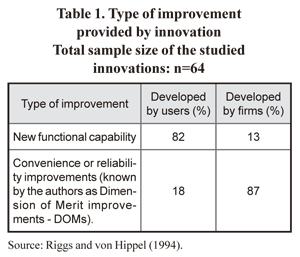
But, what is the objective incidence of user innovation? The IBM Global CEO Study 2006 analyzed different sources of innovative ideas, namely employees (slightly more than 40% of respondents), business partners (nearly 40%), customers (a bit over 35%), consultants (more than 20%), competitors (20%) and Internal R&D (nearly 20%). Thus, when we refer to user innovation, we are certainly talking about a significant source of newly made progress.
There are also different studies reporting a remarkable incidence of user innovation within a wide range of product categories (Conway, 1983). This author refers to the Pultrusion Process category, where user innovation incidence is 85%, while manufacturer innovation is 15%; the Scientific Instruments category, where these two figures are respectively 82% and 18% for the case of major improvements; or the Semicon and PC Crd Process category, where they are 63% and 21% for major improvements as well. In another study, DeMonaco et al. (2006) pointed out that, for example, referring to consumer products, in the "Extreme" Sporting Equipment and Mountain Biking Equipment categories the percentages of innovative users are quite elevated: 38% and 19%, respectively.
However, despite the evidence that user innovation is playing an important role in specific consumer and industrial product categories, very few cross-industry studies have measured user innovation incidence.
The first work to look at the phenomenon of user innovation across a range of sectors (Flowers et al., 2010, p. 4) presents "findings from a world-first survey on product innovation by consumers, and from the first cross-industry survey on user process innovation by UK firms". In their omnibus survey, they found that 8% of the United Kingdom consumers had created or modified one or more of the consumer products they were using, for them to better serve their needs. Additionally, 3.4% of them said their new or modified products were, as far as they knew, original innovations; and approximately 2% indicated that their innovations had been taken up by other users or even adopted and commercially manufactured by producers. Table 2 shows the diffusion of user innovations by the United Kingdom consumers.
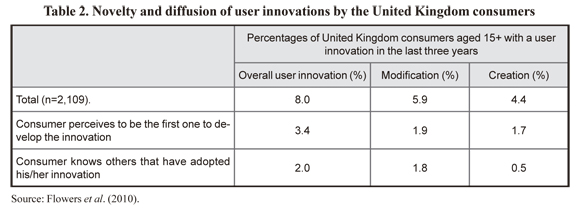
These authors also reported that the innovative consumer profile mainly corresponded to male, young and employed individuals with high academic levels. Table 3 shows the incidence of user innovation by gender, age and education.
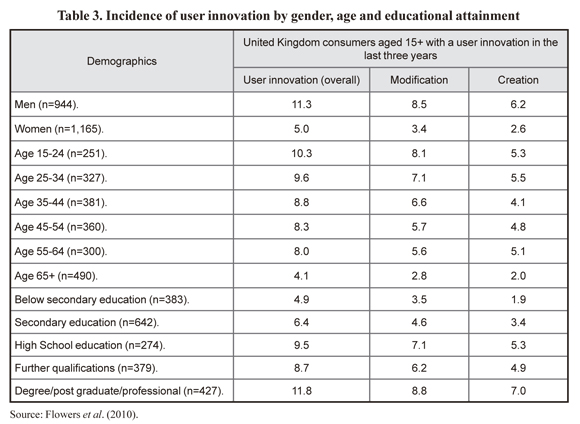
In a study carried out in Japan and the United States, Ogawa and Pongtanalert (2011) replicated the work of Flowers et al. (2010), which had taken place in the UK. Focusing on user innovation, the former authors compared the results of the three countries. In this case, manufacturer innovation was not studied. The results indicate that 3.7% and 5.2% of consumers in Japan and the United
States, respectively, had been involved in user innovation. Regarding the innovative user profile, these authors concluded that in the United States the tendency to innovation was more pronounced among people aged 55-64, executives and independent professionals (lawyers, consultants, and the like), people with undergraduate or higher degrees and those having technical education. In Japan, the tendency to innovation was stronger among retirees, free-lancers involved in commercial, industrial and service activities, doctorates, men and people aged 60-64 (Ogawa and Pongtanalert, 2011, p. 9).
3. Objective and methodology
Having reviewed the relevant literature on user innovation, the present study aimed to measure the percentage of user innovation and lead users in Gipuzkoa. We applied the methodology used in the mentioned previous studies conducted in Japan, the United Kingdom and the United States, thus contributing to its consolidation. Apart from the relevant questions asked in these prior surveys, several ad hoc questions were included in the administered questionnaire.
The resulting questionnaire addresses the following issues: creation and modification of new products, year of the innovation, time and money spent in the process, required skills and competences, availability for others to use the new development and copyright issues or patents used for its legal protection.
Making use of the convenience sampling method, the questionnaire was administered to a non-representative sample of adults in Gipuzkoa. The researchers gave three copies of the questionnaire to a convenience sample of students of the Business Administration and Communication degrees. They were asked to answer one of the questionnaires themselves, and to give one questionnaire to an adult ("a person from his/her parents' generation") and another one to a 55-year-old or older consumer ("a person from his/ her grandparents' generation").
Finally, sample size was 506 valid respondents. Individuals under 18 and those with incoherent answers were removed from the sample. The data were weighted according to the percentages of the "Gender" and "Age" categories of the whole population. The technical specifications of the survey are detailed in Table 4:

A first implicit cleaning process was applied in order to avoid false positive product creation or modification records. First, we explicitly asked for new products, so as to avoid "home-made" products imitating those already available in the market. Second, we asked only for innovations developed during leisure time, thus also avoiding innovations developed at work.
The data obtained in the field were processed with PASW Statistics 18 and R version 2.15.0.
Table 5 shows the sample's weighted data distribution. By gender, the sample is made up of 49% men and 51% women. Nearly one third of respondents were 30 or under 30 years old; just over one third were between 31 and 50; about 14% ranged from 51 to 60; and approximately 25% were over 60. According to their educational level, more than half of respondents had coursed university studies; nearly 28% had secondary education; about 13% had primary education; and only 4.7% had no qualifications whatsoever; finally, just over 12% of the sample had obtained some technical qualification.
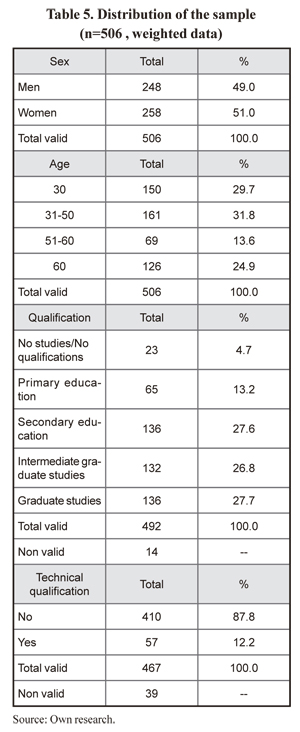
4. Results
The results report on the following issues:
- Percentage of user innovation, i.e., those individuals who answered favorably to the question on creation and / or modification of products.
- Types of user innovation described by lead users
- User innovation time and money expenditure
- Technical qualification and skills of lead users
- Diffusion of user innovations
- Lead user profile
4.1 Percentage of user innovation
The first cleaning process was completed with a second one. All the positive answers were checked in order to identify false ones. The novelty of the products (or their modifications) developed by these users was assessed by the three members of the research team. As a result, and considering they did not significantly improve any existing product, 47% of the favorable answers were removed.
After the cleaning process, we identified 5.9% of individuals who had created or modified some product throughout the last three years. They were distinguished as "new product creators" or "customizers of existing products". For this period, we found that 3.4% of respondents in the sample had created at least one new product; 3.2% had sub-stantially modified some product; and 0.6% had done both.
Table 6 compares our results to those of equivalent works conducted in Japan, the United Kingdom and the United States. In the aggregate amount, our results are quite similar to those found in the United Kingdom, with some differences, though. The modality "Only creation" is the highest one in our study (3.4%), ahead of the same figure reported for the United States (2.9%); and the modality "Only modification" holds the second place within our results and also after the same parameter's record from the United Kingdom (4.5%).
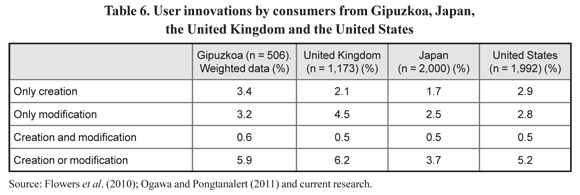
The overall percentage of user innovation is lower in these cross-market studies than in those dealing with specific product categories. In an attempt to explain these facts, Ogawa and Pongtanalert (2011) hypothesized that "those consumers belonging to communities that share a common interest in the product to be created or modified tend to help each other in the innovation process more than people who do not belong to such communities". Thus, they assume that "previous research reported higher percentages of users collaborating on innovation because it studied consumers belonging to specific communities, for example sports and hobbies" (Ogawa and Pongtanalert, 2011, p. 9). Furthermore, it seems that when the study of user innovation focuses on a product category related to sports (mountain biking equipment or extreme sporting equipment) or hobbies (outdoor, gardening or car tuning consumer products), the amount of innovation increases.
4.2 Types of user innovation described by lead users
Table 7 shows some examples of user innovation found in the current research among the surveyed lead users.
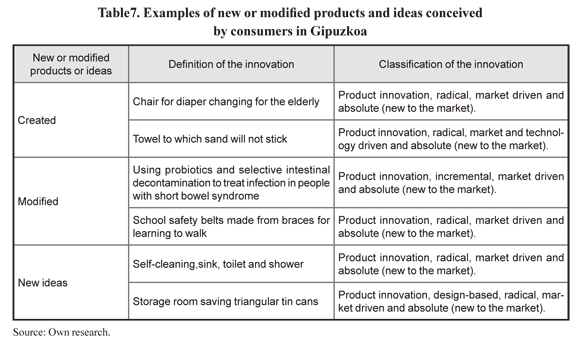
In order to study innovation types, we classified them according to the categories used in the previous studies (table 8). A quite similar pattern is observed in all cases. In our sample the most important categories are "sports and hobbies", "dwelling-related" and "other"; in the United Kingdom they are "craft and shop tools", "sports and hobbies" and "dwelling-related"; in Japan they are "dwelling-related", "other" and "vehicle-related"; and in the United States, "dwelling-related", "sports and hobbies" and "other".

4.3 User innovation time and money expenditure
We also asked respondents about the time (days) and the amount of money they had spent in developing the innovation they described.
The former parameter varies widely. On the one hand, the longest times were four and two years, corresponding to expenditures of 18,000 € and 80,000 €. On the other hand, one individual reported having spent one day, while others did not spend any money. The reduced number of individuals who answered favorably and the risk of their exhibiting a highly skewed distribution led us to be very cautious when calculating any average. Nonetheless, table 9 indicates the main statistics in question.
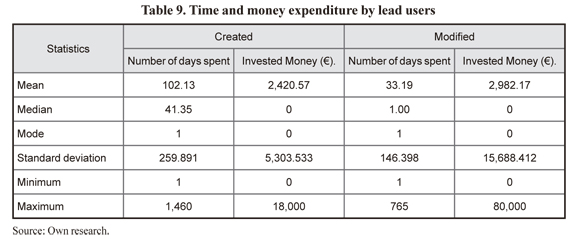
In the current work, time and money spent by innovative users were observed to differ considerably when compared to the results of studies conducted in Japan and the United States. In Japan, these parameters were 1,479 dollars and 5.5 days per person, on average; whereas in the United States they were 1,725 dollars and 9.9 days. These data are not available in the third study (conducted in the United Kingdom) to which we compared other aspects of the current one.
4.4. Technical qualification and skills of lead users
As it can be seen in table 10, most of the creators/modifiers manifested having already acquired the necessary innovation skills and expertise, also declaring that they had not really done anything special. Almost one third of these creators and 37.5% of the modifiers recognized having been in need to consult a technical expert, even though they created or modified the product almost on their own. Only 35.3% of creators and nearly 44% of modifiers had trained themselves and sought information about the innovation in question. While quite an elevated percentage of creators (70.6%) said they had to use some kind of assistance or help, only 18.8% of modifiers had to do so. In general, creators and modifiers had worked on their own. Finally, most of them admitted having received help or support from their immediate family or friends to create or modify the product.
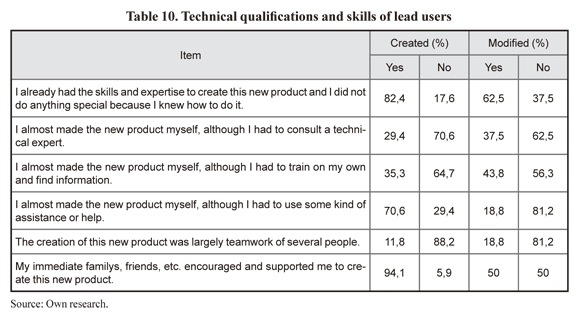
4.5 Diffusion of user innovations
Manufacturer innovation tends to be protected through patents or other intellectual property alternatives. However, user innovation tends to use very little of this kind of protection.
In our study, 13.3% answered that they had applied for a patent or other intellectual property right. This figure is quite higher than in the United States (8.8%). In the cases of the United Kingdom and Japan, table 11 shows that an extremely small number of individuals protect their innovations by applying to some kind of intellectual property right.
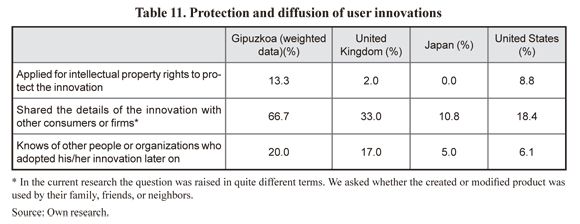
The pattern of diffusion seems to be different, too, but care must be taken with the data because the measured item is different in the current study than in those under comparison. Most of the individuals studied in this work (66.7%) said their created or modified product was used by their family, friends, or neighbors. In the contrasting studies, innovators reported having shared the details of the innovation with other consumers and firms. The results show that diffusion in any case is quite low.
Referring to the adoption of innovations by other people or organizations, our results (20.0%) are quite similar to those found in the United Kingdom (17.0%). In the United States (6.1%) and Japan (5.0%) diffusion is quite lower.
The developer of a user innovation expects to benefit by using it, while the developer of a manufacturer innovation expects a profit by selling it. Innovative users intend to fulfill their own needs, so they usually develop their innovations for themselves or for people who are close to them. The results of our study seem to be coherent with this idea.
In our research, nearly 60% of individuals reported to be the users of the new product; about 2/3 answered that the user of the innovation belonged to their family and nearly 60% said that the product was used by friends, neighbors, etc. (see table 12). The data for modified products is quite different, inasmuch as they are used mainly by modifiers themselves (62.5%), while those people close to them give less use to the innovation than in the case of created products.
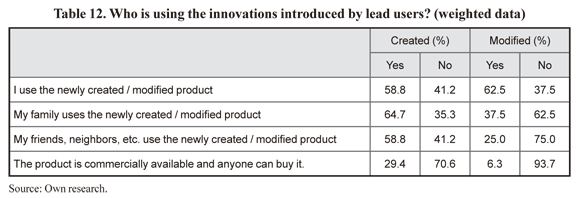
Another interesting aspect in the study of user innovation is the degree of adoption of new developments by firms. In our study, nearly one third of the product creators said the innovation was already available in the market. In the contrasting studies these results are rather lower: in Japan, the diffusion index is 5.0%; in the United States, 6.1%; and in the United Kingdom, 17.0%.
4.6 Lead user profile
But, who is on the leading edge of market trends? Who are these cutting-edge consumers? Attending to previous research on lead users, their profile is:
"In the UK, we found that being technically educated or being male significantly increased the probability that a consumer would develop or modify consumer goods. By contrast, in the United States the tendency to innovation was more pronounced in people aged 55-64, executives and independent professionals (lawyers, consultants, and the like), people with undergraduate degrees or higher and people having technical education. In Japan, the tendency to innovation was more pronounced among retirees, free-lancers involved in commercial and industrial services, people aged 60-64, doctorates and men" (Ogawa and Pongtanalert, 2011, p. 9).
Due to the sampling method employed in the present survey, it is not entirely correct to proceed to statistical analysis. Still, some trends can be recognized among individuals who reported having created a new product or having modified an available one.
By gender, the number of male lead users (individuals who answered they had created or modified a new product) is higher than that of women. Hence, an association can be observed between gender and being a lead user, as indicated by the adjusted standardized residual (+2.4).
The age range relative analysis of the sample indicates that young adults (31-50 years old) seem to be the most active lead users, as shown by the adjusted standardized residual (+3.2). By contrast, the youngest range shows a negative association with lead-userness, the adjusted standardized residual being -2.5.
According to education, in the current sample lead users have intermediate graduate studies in a higher proportion than non lead users, but the differences are not relevant. Finally, the proportion of technically qualified individuals is higher among lead users when compared to non-lead users. Conversely, the adjusted standardized residual (+2.0) indicates that the proportion of lead users is higher among individuals with technical qualification than in the total sample (see table 13).
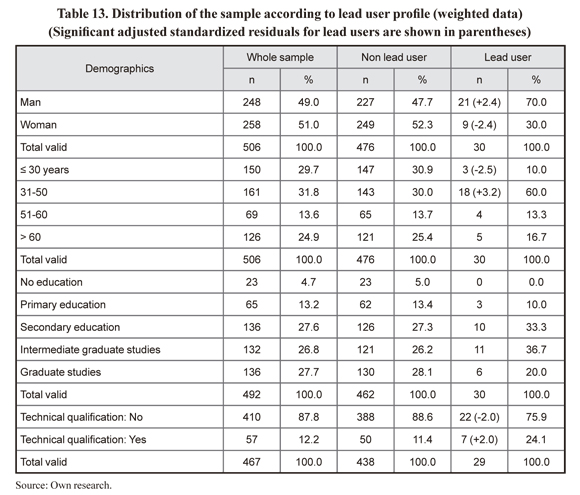
Table 14 summarizes the lead user profile features across the regions under comparison. Despite the lack of information, some similarities and differences can be observed. In Gipuzkoa, as in the United Kingdom, lead users are more often men than women; while in Japan women are more numerous. By age, in Gipuzkoa lead users tend to be young adults, which approximates the results found in the United Kingdom, where lead users are frequently young. Contrastingly, in Japan and the United States innovative users are adults. Finally, in all cases, they have reached relatively high educational levels and do have technical qualification.
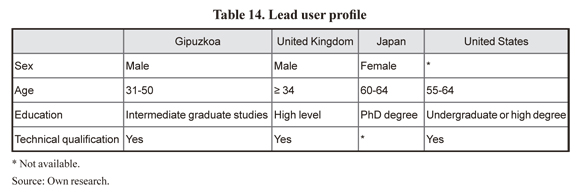
5. Conclusions and limitations
The results of this exploratory research suggest that not only manufacturers innovate; so do users, ranging from 3.7% of the analyzed individuals in Japan, to 6.2% in the United Kingdom. The percentage of user innovation is lower in these cross-market studies than in specific product surveys. Ogawa and Pongtanalert (2011) believe that users belonging to communities that share common interests tend to help one another in the process of introducing new developments. This fosters greater innovation in specific product categories than in the cross-market. In any case, the activity of these leading edge users is a non negligible source of attractive new products.
User innovation is mainly related to sports, hobby or home products. Other important categories are craft and shop tools in the United Kingdom and vehicle-related products in Japan. Medical products are not irrelevant in Gipuzkoa, one of the European regions with the highest elderly population, which might be pushing lead users in the region to innovate in the fields of medicine and home.
Although the products generated by lead users could be considered somewhat substandard, it doesn't seem appropriate to underestimate the ideas behind these creations, as they may have great market appeal. Furthermore, they should be considered by companies within their innovation processes, and by governments when it comes to re-defining innovation policies.
It seems that the users surveyed in this work do not have great barriers to share their innovations with manufacturers. An extremely small number of individuals protect their new developments by applying to some kind of intellectual property right. There might be some missing bridges linking both sides of the market. In this sense, it would be interesting to explore a way to open business to users and to have companies attract the most innovative of them. The results derived from the Openbasque project (http://www.open-basque.net), which is currently being executed in Gipuzkoa and some neighboring regions, could be of great value.
Although there are not many lead users in the group analyzed in the present work, they do seem to share some features, corresponding to adult, educated men with technical training. Our research team is currently deepening into the profile of these people through a lead user featuring scale whose reliability and validity shall have to be tested by future research work.
Just as Ogawa and Pongtanalert (2011) in Japan and the United States, in Gipuzkoa we used the methodology proposed by Flowers et al. (2010), which, as far as now seems to be valid and applicable to different regions as well. In this sense, it would be interesting to know the status of user innovation not only in a representative sample from the region of Gipuzkoa, but also in places with different degrees of development, especially emerging markets.
It is mandatory to mention the limitations of this research. Although the sample size is large enough for the region under study, the sampling method is not a probabilistic one. Due to strong economic constraints, it was not possible to select a representative sample. To curtail this problem, we weighted the data according to the percentage of the "Gender" and "Age" categories in the whole population.
Likewise, as we could not have direct access to data from the United Kingdom, Japan and the United States, we were not able to compare every item. The creation of a large inter-regional survey on user innovation is a desideratum of this research team.
To conclude, research results suggest that innovation policy and management focusing only on the manufacturer are at least incomplete. Although not currently invited to innovation processes, users are innovating. If we want to exploit all the innovative potential of society, we need to incorporate them to the innovation system and facilitate their joint work with manufacturers.
References
Baldwin, C., Hiernerth, C. and von Hippel, E. (2006). How user innovations become commercial products: A theoretical investigation and case study. Research Policy, 35, 1291-1313. [ Links ]
Berger, A. J. (1975). Factors influencing the locus of innovation activity leading to scientific instrument and plastics innovation. SM thesis, Cambridge, MA: Sloan School of Management, MIT. [ Links ]
Boyden, J.W. (1976). A Study of the innovative Process in the Plastics Additives Industry. SM thesis. Cambridge, MA: Sloan School of Management, MIT. [ Links ]
Conway, S. (1993). The role of users in the innovation process. Doctoral Working Paper Series, 10 (NS). Aston Business School. [ Links ]
DeMonaco, H.J., Ali, A. and von Hippel, E. (2005). The major role of clinicians in the discovery of off-label drug therapies. Working paper. MIT Sloan. [ Links ]
Dosi, G. (1982). Technological paradigms and technological trajectories: a suggested interpretation of the determinants and directions of technical change. Research Policy, 11, 147-162. [ Links ]
Flowers, S., Grantham, A., Mateos-Garcia, J., Nightingale, P., Sapsed, J., Tang, P. and Voss, G. (2008). The new inventors; how users are changing the rules of innovation. London: NESTA. [ Links ]
Flowers, S. and Henwood, F. (2010). Perspectives on user innovation. London: Imperial College Press. [ Links ]
Flowers, S., von Hippel, E., de Jong, J. and Sinozic, T. (2010). Measuring user innovation in the UK. The importance of product creation by users. Research report, April, 2010. NESTA. [ Links ]
Fontana, R. and Guerzoni, M. (2008). Incentives and uncertainty: An empirical analysis of the impact of demand on innovation. Cambridge Journal of Economics, 32, 927-946. [ Links ]
Franke, N. and Shah, S. (2003). How communities support innovative activities: An exploration of assistance and sharing among end-users. Research Policy, 32 (1), 157-178. [ Links ]
Franke, N. and von Hippel, E. (2003). Finding commercially attractive user innovations. MIT Sloan School of Management, Working Paper No. 4402-03. [ Links ]
Franke, N., von Hippel, E. and Schreier, M. (2006). Finding commercially attractive user innovations: A test of lead-user theory. Journal of Product Innovation Management, 23, 301-315. [ Links ]
Freeman, C. (1968). Chemical process plant: Innovation and the world market. National Institute Economic Review, 45, 29-57. [ Links ]
Gardiner, P. and Rothwell, R. (1985). Tough customers: Good designs. Design Studies, 6 (1), 7-17. [ Links ]
Gault, F. (2011). User innovation and the market. Retrieved on January 25, 2011, from SSRN: http://ssrn.com/abstract=1949182 or http://dx.doi.org/10.2139/ssrn.1949182 [ Links ]
Gault, F. and von Hippel, E. (2009). The prevalence of user innovation and free innovation transfers: Implications for statistical indicators and innovation policy. MIT Sloan School of Management, Working Paper No. 4722-09, Cambridge, MA: MIT. Retrieved from: http://ssrn.com/abstract=1337232 [ Links ]
Guerzoni, M. (2007). The impact of market size and users' sophistication on innovation: The patterns of demand and the technology life cycle. Jena Economic Research Papers, 46, 1-41. [ Links ]
Henkel, J. and von Hippel, E. (2005). Welfare implications of user innovation. Journal of Technology Transfer, 30 (1/2), 73-87. [ Links ]
Herstatt, C. and von Hippel, E. (1992). From experience: Developing new product concepts via the lead user method: A case study in a "low tech" field. Journal of Product Innovation Management, 9 (3), 213-222. [ Links ]
IBM Global CEO Study (2006). Expanding the innovation horizon. The Global CEO Study 2006. IBM Global Business Services. [ Links ]
Ienson, R.S. (1969). Project hindsight: An empirical study of the sources of ideas utilized in operational weapon systems. In: Gruber, William H. and Marquis, Donald G. (Eds.), Factors in the transfer of technology. Cambridge, MA: MIT Press. [ Links ]
Kim, Y. and Kim, H. (2011). User innovation in Korean manufacturing firms: Incidence and protection. KAIST Business School Working Paper Series KCB-WP-2011-01, Seoul: KAIST Business School. [ Links ]
Langrish, J., Gibbons, M. Evans, W. G. and Jevons, F. R. (1972). Wealthfrom knowledge: A study of innovation in industry. New York: John Wiley. [ Links ]
Leadbeater, C. (2006). The user innovation revolution. London: NCC. [ Links ]
Lettl, C., Herstatt, C. and Gemuenden, H. G. (2006). Users' contributions to radical innovation: Evidence from four cases in the field of medical equipment technology. R & D Management, 36 (3), 251-272. [ Links ]
Lilien, G.L., Morrison, P.D., Searls, K., Sonnack, M. and von Hippel, E. (2002). Performance assessment of the lead user idea generation process. Management Science, 48 (8), 1042-1059. [ Links ]
Lionetta, W. G. (1977). Sources of innovation within the pultrusion industry. Unpublished. SM thesis, Sloan School of Management, Cambridge, MA: MIT. [ Links ]
Lüthje, C. (2003). Customers as co-inventors: An empirical analysis of the antecedents of customer-driven innovations in the field of medical equipment. Proceedings of the 32nd EMAC Conference. [ Links ]
Lüthje, C. (2004). Characteristics of innovating users in a consumer goods field: An empirical study of sport-related product consumers. Tech-novation, forthcoming. [ Links ]
Lüthje, C., Herstatt, C. and von Hippel, E. (2002). The dominant role of local information in user innovation: The case of mountain biking. MIT Sloan School of Management, Working Paper No. 4377-02. [ Links ]
Luthje, C., Herstatt, C. and von Hippel, E. (2005). User-innovators and 'local' information: The case of mountain biking. Research Policy, 34 (6), 951-965. [ Links ]
Ministry of Employment and the Economy (2010). Demand and user-driven innovation policy. Helsinki: Ministry of Employment and the Economy. [ Links ]
Morrison, P. D., Roberts, J. H. and Midgley, D. F. (2004). The nature of lead users and measurement of leading edge status. Research Policy, 33 (2), 351-362. [ Links ]
Morrison, P.D., Roberts, J.H. and von Hippel, E. (2000). Determinants of user innovation and innovation sharing in a local market. Management Science, 46 (12), 1513-1527. [ Links ]
Mowery, D.C. and Rosenberg, N. (1979). The influence of market demand upon innovation: A critical review of some recent empirical studies. Research Policies, 8, 102-153. [ Links ]
Myers, S. and Marquis, D. G. (1969). Successful industrial innovation. Washington: National Science Foundation. [ Links ]
National Science Foundation (1959). Report on project TRACES. Washington: National Science Foundation. [ Links ]
Ogawa, S. and Pongtanalert, K. (2011). Visualizing invisible innovation continent: Evidence from global consumer innovation surveys. Retrieved on June 30, 2012, from: SSRN: http://ssrn.com/abstract=1876186 or http://dx.doi.org/10.2139/ssrn.1876186. [ Links ]
Porter, M.E. (2007). Ser competitivo. Nuevas aportaciones y conclusiones. Ediciones Deusto. [ Links ]
Riggs, W. and von Hippel, E. (1994). Incentives to innovate and the sources of innovation: The case of scientific instruments. Research Policy, 23, 459-469. [ Links ]
Rotnes, R. and Staalesen, P. D. (2009). New methods for user driven innovation in the health care sector. ECON Põyry AS. Retrieved from: http://www.nordicinnovation.net [ Links ]
Rothwell, R., Freeman, C., Horlsey, A., Jervis, V. T. P., Robertson, A. B. and Townsend, J. (1974). SAPPHO updated - project SAPPHO phase II. Research Policy, 3, 258-291. [ Links ]
Schaan, S. and Uhrbach, M. (2009). Measuring user innovation in Canadian manufacturing, 2007. Catalogue No. 88F0062009003, Ottawa: Statistics Canada. [ Links ]
Schreier, M. and Prügl, R. (2008). Extending lead-user theory: Antecedents and consequences of consumers' lead userness. Journal of Product Innovation Management, 25, 331-346. [ Links ]
Schmookler, J. (1962). Economic sources of inventive activity. Journal of Economic History, 22 (1), 1-20. [ Links ]
Schmookler, J. (1966). Invention and Economic Growth, Cambridge, MA: Harvard University Press. [ Links ]
Thomke, S. and von Hippel, E. (2002). Customers as innovators: A new way to create value. Harvard Business Review, 80 (4), 74-81. [ Links ]
Tietz, R., Morrison, P. D., Lüthje, C. and Herstatt, C. (2005). The process of user-innovation: A case study in a consumer goods setting. International Journal of Product Development, 2 (4), 321-338. [ Links ]
Ulwick, A.W. (2002). Turn customer input into innovation. Harvard Business Review, 80 (1), 91-97. [ Links ]
Urban, G.L. and von Hippel E. (1988). Lead user analyses for the development of new industrial products. Management Science, 34 (5), 569-82. [ Links ]
Von Hippel, E. (1986). Lead users: A source of novel product concepts. Management Science, 32 (7), 791-805. [ Links ]
Von Hippel, E. (1988). The sources of innovation. Oxford University Press. Retrieved from: http://web.mit.edu/evhippel/www [ Links ]
Von Hippel, E. (2001). Perspective: User toolkits for innovation. Journal of Product Innovation Management, 18 (4), 247-257. [ Links ]
Von Hippel, E. (2005). Democratizing innovation. Cambridge, MA: MIT Press. [ Links ]
Von Hippel, E., de Jong, J. and Flowers, S. (2010). Comparing business and household sector innovation in consumer products: Findings from a representative study in the UK. Retrieved from SSRN: http://ssrn.com/abstract=1683503. [ Links ]
Von Tunzelmann, N. and Wang, Q. (2003). An Evolutionary view of dynamic capabilities. Economie Appliquée, 6, 33-64. [ Links ]













